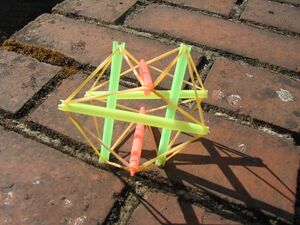Biotensegrity
Original Editor - User Name
Top Contributors - Vidya Acharya
Introduction[edit | edit source]
Mechanical stimuli is important in organ development, tissue homeostasis, as well as disease process[1]. The cells not only sense biochemical cues but also physical factors such as force, geometry and matrix elasticity. This is crucial for defining cell and tissue functions, morphology, regeneration, physiology and pathology. [2] Mechanobiology is the study of the essential roles that these physical factors play via the process of mechanotransduction. Cellular mechano-transduction is a process in which cells sense physical forces and transduce these mechanical cues into changes in intracellular biochemistry and gene expression.[3] At the tissue level, multicellular structures are held together by cell adhesions. Forces acting upon these adhesions play an integral role in dynamically re-shaping multicellular structures. In a multicellular structure, mechanical forces are transduced in a variety of ways, including mechanosensing through a compliant substratum, cytoskeletal 'tug-of-war' between cell-matrix and cell-cell adhesions, cortical contractility that contributes to line tension, stresses caused by cell proliferation, and forces mediating collective migration.[3] The cells use tensegrity architecture to structure themselves at the molecular level, and that depends on tensile prestress for its mechanical stability enables cells to sense and respond to mechanical signals.[3]Tensegrity
Tensegrity[edit | edit source]
According to Merriam-webster dictionary, tensegrity means the property of a skeletal structure having continuous tension members (such as wires) and discontinuous compression members (such as metal tubes) so that each member performs efficiently in producing a rigid form.[4]. The term ‘tensegrity’ combines the words ‘tension’ and ‘integrity’. It was first coined by the architect Buckminster Fuller[5]. It refers to any physical structure that combines the features of tension and stability in a specific manner. The structures that maintain their integrity primarily because of balance of woven tensile force continual through the structure as opposed to relying on compressive forces as seen in a column or a wall.[6]
Rigid elements, such as struts or beams, are held together by a network of tensioned elements of structures like cables, strings or even membranes.[7] So, the rigid structures are not held or connected by compression as we see in a wall where bricks are stacked upon each other. Instead, they are connected through a global network of tension. The rigid struts seem to float in a continuum of tensile forces. This arrangement gives shape and stability and also determines the behaviour of structure when subjected to external forces [5][7]. The forces are transmitted through the entire structure, affecting every single component. The individual components realign themselves immediately when the when force is exerted on any particular component, and they do so in a reversible manner without undergoing any damage. If we pull a string in the tensegrity model or a strut is broken, the whole arrangement will reorient itself to accommodate the change. Also, as a result of the interconnectedness of the structural elements, tensile forces are distributed across the whole tensegrity structure. This implies that a force applied in a specific area may cause a reaction in the whole structure.
Biotensegrity[edit | edit source]
Resources[edit | edit source]
- bulleted list
- x
or
- numbered list
- x
References[edit | edit source]
- ↑ Kim AA, Nekimken AL, Fechner S, O’Brien LE, Pruitt BL. Microfluidics for mechanobiology of model organisms. InMethods in cell biology 2018 Jan 1 (Vol. 146, pp. 217-259). Academic Press.
- ↑ Lim CT, Bershadsky A, Sheetz MP. Mechanobiology. Journal of The Royal Society Interface. 2010 Jun 6;7(suppl_3):S291-3.
- ↑ 3.0 3.1 3.2 Ingber DE, Wang N, Stamenović D. Tensegrity, cellular biophysics, and the mechanics of living systems. Reports on Progress in Physics. 2014 Apr 2;77(4):046603.
- ↑ https://www.merriam-webster.com/dictionary/tensegrity#:~:text=ten%C2%B7%E2%80%8Bseg%C2%B7%E2%80%8Bri,in%20producing%20a%20rigid%20form
- ↑ 5.0 5.1 Ingber DE, Wang N, Stamenović D. Tensegrity, cellular biophysics, and the mechanics of living systems. Reports on Progress in Physics. 2014 Apr 2;77(4):046603.
- ↑ A Fascial Reader Anatomy Trains Thomas W.Myers 4th Edition
- ↑ 7.0 7.1 Hohenschurz-Schmidt DJ, Esteves JE, Thomson OP. Tensegrity and manual therapy practice: a qualitative study. International Journal of Osteopathic Medicine. 2016 Sep 1;21:5-18.







